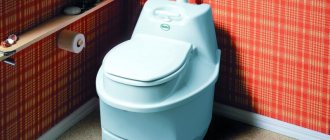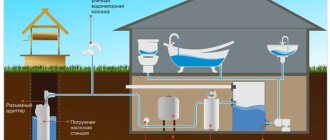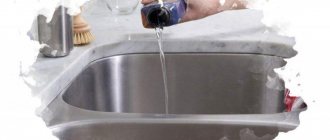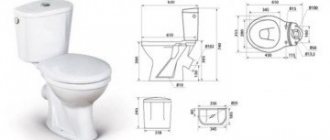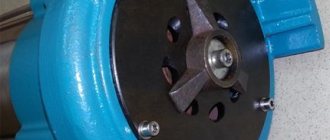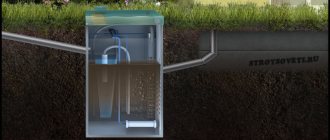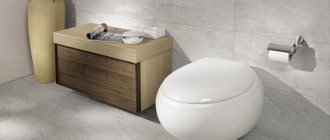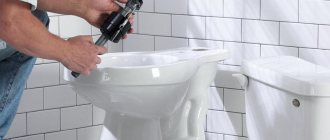It is very easy to live in a system where choices are limited, or where someone else decides for the individual. And how complicated everything becomes when the number of choices tends to infinity. It seems that quite recently, when repairing a toilet, residents of the CIS countries did not have any problems when purchasing a toilet. None. The plumbing products were identical, like twin brothers: they had the same shape, color and design. The only difference between them was their quality: some served for decades, others required replacement after a few years. That's why there were huge queues for Finnish plumbing fixtures.
Today, hundreds of toilets are displayed on the display shelves of large retail chains, and not one of them is like the other. They differ in color, material from which they are made, shape, and design.
Plumbing fixtures can come in the most unexpected shapes.
The choice of color and shape is made based on the taste of the owners, the style of the apartment in general and the toilet in particular. By design, many buyers are encountering a new product for the first time, which experts call installation. To understand how this system works and is installed, to understand what the installation’s pros and cons are, buyers are forced to look for answers on various forums.
However, the development of IT technologies, along with its benefits, often brings harm. First of all, this applies to forums. Competing companies do not always compete fairly and launch bots that write negative reviews about new products. Therefore, the editors of the site decided, with the help of specialists, to understand the design of a new type of toilet, its strengths and weaknesses. The explanations and assessments received formed the basis for recommendations on what to choose - an installation or a regular toilet.
Hanging sanitary ware is durable and reliable
This design is only fragile in appearance, “floating”, but in reality it is no less reliable than plumbing fixtures standing firmly on the ground.
Sink faucets: 5 current options
In pursuit of convenience and durability, the main thing is not to lose sight of the third “whale” - visual harmony. We have collected the TOP 5 current options for faucets from the Lanskoy shopping center for different interior styles.
With proper installation, a wall-hung toilet can withstand a load of up to 400 kilograms.
The reliability of the installation is ensured by the technical design. Instead of a traditional mounting leg, the toilet bowl is supported on a massive, high-strength frame, usually steel. The frame, along with the tank and drain lines, is hidden behind a false wall. This design is practically invulnerable, serves for a long time and properly. Access to the tank, if necessary, is provided through the flush button, which is installed above the toilet.
Two types of toilets
There are two types of toilets - floor-mounted and installation-mounted. Floor-standing toilets are familiar to everyone and have been used in city houses for decades. Installation systems have become widespread practice over the last couple of decades. Within the types there are different execution options. There are corner versions of the flush cistern for installation in a corner to two adjacent walls. There is an option called a "mounted toilet" with a hidden cistern. Each of these types has its own advantages and disadvantages. Flush tanks can be suspended or floor-mounted. The final choice is determined by a set of technical characteristics, fashion and design requirements, and the thickness of the apartment owner’s wallet.
Wall hung and floor mounted toilets
A bathroom with installation is more convenient in everyday life
Cleaning the bathroom becomes much easier thanks to the open space below and above the toilet bowl. There are no obstacles in the way of a damp cloth on the floor or wall, no hard-to-reach places that can harbor bacteria. A “floating” toilet is hygienic.
Another household advantage of a wall-hung toilet is less noise when flushing water. If you equip the false wall behind which the tank is hidden with soundproofing material, the operation of the drain mechanism will become absolutely silent.
Monoblock
The production of monoblocks has become a real alternative to installation due to a number of advantages that compact toilets do not have:
- simple equipment - solid cast toilet;
- ergonomic shape of the bowl - it is comfortable for any family member to sit, even with disabilities;
- smaller linear dimensions, which is why it requires less space than a classic “compact” toilet;
- easy maintenance – the absence of a “dead zone” makes cleaning the bathroom easier;
- easy installation;
- the presence of a microlift - the lid lowers smoothly and silently;
- some models are available as a shower toilet (this feature also appeared on compact toilets);
- no leaks at the drain tank;
- efficiency - most models use several drain modes.
The disadvantages include:
- higher price compared to compact models;
- the inability to repair the tank drain system (theoretically, it is possible to replace a failed element, but in practice it is extremely difficult) - only a complete replacement of the fittings, which is quite expensive.
You can save space
Visually and literally. The installation looks neater than traditional solutions, since it hides all the “stuffing” behind the wall, and the effect of a floating bowl visually unloads the space. It seems that there is more space in the bathroom.
A wall-hung analogue of traditional plumbing fixtures is the optimal solution for a small bathroom. The entire technical structure will “eat” less centimeters than the volumetric cistern of a floor-standing toilet and its mounting leg. The depth of the tank of conventional models varies from 18 to 20 centimeters; for suspended models it is 11 centimeters or less.
How to choose correctly. Adviсe
- A circular flush maintains cleanliness much better.
- The tank flush button can be connected to the fittings using pneumatics or mechanical devices (cable/lever). The latter are considered more reliable.
- To save water, you can install a system to stop the drain when you press the button again. Also pay attention to the two-button flush, when only half of the tank or its entire volume is used.
- Plumbing products from Germany and Italy have proven themselves best. Bulgaria and the Czech Republic produce high-quality products in the mid-price category.
Electronic shower toilet - Despite the external miniature of the device, before purchasing it is necessary to take measurements and compare them with the dimensions of the bathroom.
- If you are thinking about purchasing an additional bidet, please note that some models of wall-hung toilets already have this function.
- Before purchasing, be sure to read the quality certificates, technical documentation, and make sure there is a warranty. This way you will protect yourself from frequent repairs, and the purchased plumbing equipment will not fail prematurely.
The price of hanging plumbing is higher
It is generally accepted that floating analogues are more expensive than toilets on a support. This is often true, but it depends on what you compare. If you contrast an imported installation with a low-cost budget model of a traditional toilet, the latter will be cheaper, but if you compare models in the same segment and from similar manufacturers, the wall-hung option may turn out to be even more affordable.
What will really cost more is the installation of a suspended model. Especially when it comes to renovating secondary housing.
If the installation replaces a floor structure, the sewer wiring will need to be redone.
What and in what case is it better to choose
In Western Europe, 90% of toilets are installations. They can count there. The more expensive version of the sanitary ware pays off in terms of water savings, long service life, compactness, hygiene, convenience and unusually beautiful design.
The same factors are at work in Russia. But here financial opportunities come first, as a result of which we are far behind in this matter. If you have money, the best option is installation. No - you will have to choose a classic type toilet.
Failure may result in the wall being dismantled
If it comes to a breakdown, the wall may need to be dismantled, so just in case, it’s worth having the necessary finishing material in reserve to restore what was destroyed.
Most often, you are forced to resort to disassembling the wall because the drain button is not large enough, through which access to communications is provided.
If the installation breaks down, you cannot do without professional plumbing help. This is not a reason to be afraid of “walled up” communications. The built-in tank is made of plastic and is in little danger, and the drain system can usually be replaced using a button.
Photo: paguponhome.comTypes of installations
Block system
This is the simplest and most cost-effective system, which, however, has a significant limitation in operation: installation of the installation is possible only on a load-bearing main wall. Plasterboard partitions are by no means suitable for such a system. The structure consists of the following elements:
- plastic tank;
- mounting plates with anchors;
- a set of studs that are needed to secure the toilet.
Photo: lawathasglass.com
Frame system
Calculate the exact cost of repairs using an online calculator
and receive a free detailed estimate for repairs
Calculate
The frame system is much more complex and expensive than the block system. The structure consists of a steel frame with an anti-corrosion coating, which is supplied with fittings for fastening the installation and devices hung on it. Unlike a block system, a frame system does not have to be attached to a load-bearing wall. Here, in principle, the strength of the walls does not play any role.
However, it should be borne in mind that the fasteners directly depend on the material of the partitions:
- load-bearing concrete floor - wall mounting, in which the entire load falls on the wall;
- plasterboard or foam block partitions - floor installation, in which case the frame is installed on special legs.
If you still doubt the reliability of such a system, use a special combined model, which provides fastening on both a vertical and horizontal surface using four holes.
Disadvantages of a built-in toilet installation
The main disadvantage of built-in toilets is the unreliability of the design. As a rule, fastening occurs on a special metal frame recessed into the wall. The toilet itself seems to “hang” in the air, connecting to the wall only at the place where the fastening line and sewer pipe are connected. On the wall there is only a nickel plated panel with flush buttons.
In Russian conditions, it should be remembered that installation is not always carried out professionally. We still have few professional plumbers. Agree that when this profession is mentioned, people usually have the image of “Uncle Vasya from the housing office. The installation is carried out using a “brain” and without carefully studying the drawings and diagrams, which are always included with imported plumbing fixtures (but in a language foreign to plumbers, and if there is a translation, it is very clumsy). Therefore, when rather overweight people regularly sit on a plumbing fixture, after a couple of years it begins to quietly leak and become covered with a “mesh” of cracks in the ceramic. There is only one way out: if you decide to install such beauty in your bathroom, then you need to verify the qualifications of the installer in advance in practice (reviews, look at the work at least three years ago).
Other disadvantages of a built-in toilet include:
- Installations are not cheap. The cost is much higher than conventional fixed plumbing fixtures.
- If the drain tank malfunctions, you have to disassemble the wall to access the problem area.
- To install a built-in tank, you need space: either in the wall or space for a hanging panel that holds the entire structure.
The last point is especially important - sometimes apartment owners “crawl” into the ventilation unit in the bathroom, installing a frame with a cistern there. Thereby blocking the air flow for neighbors. What to do is strictly prohibited. Or by installing the structure in a niche made in a load-bearing wall. Which is also prohibited. In short, choosing a place for a toilet installation in our small bathrooms is very difficult.
Otherwise, the built-in toilet installation is beautiful, convenient and comfortable. From the “Experienced Plumber” we would like to add that during installation it is necessary to adjust the seat height to the most comfortable “fit”. That is, before finally fixing the system, you need to sit down and stand up several times, invite all family members to “try on” and only then make the final decision on the height of the toilet. For those who prefer a regular plumbing toilet, we invite you to read the following article - about a stationary device, its pros and cons, with advice from an experienced plumber (where would we be without them:) Good luck with your purchase.
I will be grateful if you press the buttons :)))
Advantages and reviews
Today, such installed equipment as a wall-hung toilet is considered the most advanced.
Installing a wall-hung toilet is quite easy, and the design is quite unified, which allows you to use products from any manufacturer.
The height above the floor is usually 15 cm , which makes it easy to clean underneath.
Flushing water is carried out in two main ways. With dynamic water, which is an average of 4 liters, instantly forms a whirlpool and flushes away. The static method involves draining like a waterfall. Sometimes they are used together, which gives reliable results.
The funnel-shaped bowl avoids unnecessary odors and eliminates splashes from water . The noise from the drain is also virtually inaudible.
Design solutions allow the wall-hung toilet to fit into any room and do not depend on the total area.
But the reliability of the bowl itself and ease of maintenance are noted by everyone who has already purchased this plumbing fixture. The location of the cistern is of particular delight It is not visible to the eye, but at the same time removing the button and turning off the tap is extremely easy and unburdensome.
The water-repellent enamel coating prevents limescale deposits and allows water to drain quickly.
Reviews that can be found on the Internet say only one thing. If anyone has not yet managed to purchase a wall-hung toilet, then they are simply wasting time . Therefore, you should not put off going to the store. Even an inexpensive model will be able to serve reliably and properly and will completely transform your toilet or bathroom for the better.
Main characteristics of classic toilets
The classic type of toilet is a structure that is attached to the floor and behind which is a flush cistern. The main advantage of a classic-shaped toilet is that it can be mounted anywhere in the toilet room.
A classic toilet takes up approximately 50 cm more than any wall-hung structure, the cistern of which is built into the wall. Now there is a huge variety of design and style solutions for classic toilets, but in any case, the cistern is located outside - monolithic with the toilet, mounted on the wall, located nearby.
Is an installation always more expensive than a conventional toilet?
When choosing a particular form of toilet, pay attention to everything - color, material, shape, sit on it. If you want to use this product in everyday life, it should be, first of all, practical and aesthetic for you. The fleeting euphoria of a beautiful shape when purchasing can result in inconvenience in use, so check your preferences carefully.
When choosing a toilet, much depends on the design solution of a particular product—both classic toilets and installations in this case have a wide variety. The material from which the plumbing item is made is of great importance - plastic, cast iron, steel, glass, earthenware, porcelain. Porcelain is considered the most expensive, beautiful and durable material. It is easy to clean and not as hygroscopic as earthenware. The simplest toilets in terms of shape and materials have the lowest prices . The design solution of a product always raises the price, but most often it relates only to the appearance and does not affect the basic functions of the toilet.
It is worth noting that the toilet itself and the installation system have separate prices and are almost equal to each other, that is, it is
twice as expensive as a similar set of a classic toilet.
But - as already mentioned - all parts of the installation structure can be purchased separately and, thanks to production standards, they will always fit together. Classic monolithic floor-standing toilets have a fairly high price, while those externally stylized as antique with modern functions are the most expensive.
It’s worth considering when purchasing that installers charge 10–15 percent of the cost of the toilet for installation. If you can install a classic standard toilet yourself, then when installing the installation you cannot do without professional service.
What to look for when purchasing
A toilet for installation is as ambiguous a concept as the installation device itself (installation, which in translation means the same process, but sounds much more aesthetically pleasing and tempting).
Experts believe that, apart from cost, there is no particular basis for arguments in favor of conventional or suspended equipment:
- An attached one, just like a wall-mounted one, can do without a back tank, and craftsmen learned to hide all plumbing equipment in cabinets and niches back in Soviet times. However, for some homeowners, its location or the ability to maintain sterile cleanliness is of fundamental importance.
- Installation for a wall-hung toilet is not a plumbing system, as it might seem from the descriptions of the advantages and installation methods presented on construction sites. This is a special structure, usually metal or made of a metal profile, designed to mount a toilet. It contains a small flush cistern that can be built into the wall without much difficulty.
- The size of the installation for a toilet is always selected individually, because the presence of pipes for connection, special pipes, elbows and bends implies a specific model. Usually it is tied to certain brands of toilet. Therefore, it is recommended to buy them as a set, so as not to have to put together an intricate puzzle later.
- When purchasing, you should consider various points, including common sense considerations, arguments from supporters of traditional installation, and arguments in favor of wall-mounted plumbing.
For corner installation, an attached tank is recommended; the frame can be used for a bidet or sink, and if your plans do not include remodeling the entire sewer system, purchasing a false frame or special panels, then it is better to choose a simpler option. You can’t keep up with fashion, more advanced options appear, and the myth about the absence of breakdowns is nothing more than an advertising ploy from the manufacturer.
It is no coincidence that the main emphasis in the recommendations is on branded products with a high degree of reliability. The main point that needs to be taken into account if you are purchasing not a set, but individual components, is the correspondence of types and sizes.
Layouts and detailed instructions for laying tiles in the bathroom with your own handsHow to stylishly, efficiently and inexpensively decorate a bathroom with plastic panels yourself
How to design a bathroom yourself - the best ready-made design ideas, 100+ examples with photos
Advantages of a built-in toilet installation
The built-in toilet reveals only the toilet seat itself. The tank with the mounting system is hidden in the wall or covered with a special panel. This design looks fashionable and modern, allows you to save space in small bathrooms and create space and an atmosphere of ease of life in large bathrooms. Convenience of cleaning can also be added to the advantages - it’s easy to wash the floor under the installation. But, like everything beautiful and convenient, the toilet installation also has its drawbacks (as people say: “Beauty requires sacrifice”:)
Several arguments in favor
It should be noted that wall-hung toilets became popular in the West, and especially in America, in the late 80s. Since then, many modifications have appeared, but today this plumbing device is considered one of the most modern and best. This alone suggests that the service life is quite long, as well as ease of maintenance.
This toilet takes up
much less space , since the flush cistern is built into a niche and is located, practically, almost on the same level with the bowl.
The shape of the bowl itself, although it is considered traditional, nevertheless does not have a bulky foot. This allows you to place the same tile directly under the toilet. Cleaning will not be difficult, since you only need to wipe the floor with disinfectants.
In small bathrooms, this design not only looks attractive, but also visually adds space to the room. Moreover, the designer shapes make it possible to make it an even more beautiful and stylish piece of furniture.
However, this does not mean that there is no place for such a toilet in a large toilet. After all, there is actually very little noise from draining water This is due to the fact that the drain tank is securely covered.
In addition to compactness and reliability, it should also be noted that it is easy to maintain , which takes a minimum of time and effort.
Let's sum it up
- A priori, installing the simplest installation process is in any case twice as expensive as a classic toilet with similar characteristics. Plus - if you can install the toilet yourself, then most likely you will have to invite a specialist for installation.
- In any case, there must be a very strong platform for mounting the installation - either the floor or the wall.
- The installation of the installation must be taken into account when designing the toilet - it is necessary to take into account the nuances of access to the wall in case of repair.
- If you want to install the installation somewhere in the country far from the service department, get ready for the fact that you will need to be able to understand the system yourself.
In principle, both the installation toilet and the classic forms of this necessary item have a wide variety in terms of style and options - you can choose according to your taste and the amount you plan to allocate for the purchase. In this case, the choice comes from the spatial design of your toilet room and from your personal preferences in the use of certain items in everyday life. This important element of everyday life should also be aesthetic, practical and calm.
Disadvantages of devices
If you decide to buy a wall-hung toilet, you should definitely consider the pros and cons of its installation, design and operation. Indeed, in addition to its advantages, it also has a number of disadvantages.
- It costs more than floor-standing models. So, you will have to pay not only for the toilet itself, but also for the installation system.
- The installation itself also costs a little more.
- If some kind of breakdown occurs in the system, it will have to be disassembled almost completely in order to carry out repair work.
